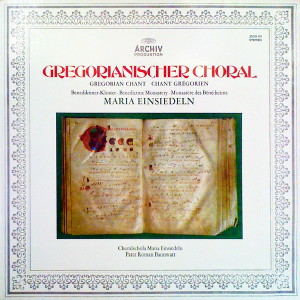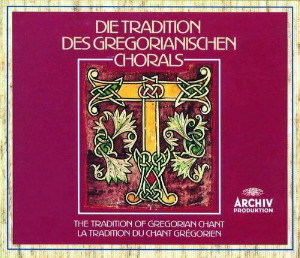 |
|
1 LP -
2533 131 - (p) 1973
|
 |
| 4 CD's -
435 032-2 - (c) 1993 |
|
| THE TRADITION OF
THE GREGORIAN CHANT - (I) |
|
|
|
|
|
|
|
|
MARIA
EINSIEDELN - Benedictine Monastery
|
|
|
|
|
|
|
|
|
|
| PROPRIUM
PRIMAE MISSAE IN NATIVITATE |
|
|
11' 18" |
A1 |
| -
Introitus: Dominus dixit |
Modus
II
|
1' 44" |
|
|
| -
Graduale: Tecum principium |
Modus
II |
4' 24" |
|
|
| -
Alleluia: Dominus dixit |
Modus
VIII |
2' 45" |
|
|
| -
Offertorium: Laetentur caeli |
Modus
IV |
1' 14" |
|
|
| -
Communio: In splendoribus |
Modus
VI |
0' 40" |
|
|
| PROPRIUM
MISSAE IN EPHIPHANIA DOMINI |
|
|
11' 13" |
A2 |
| -
Introitus: Ecce advenit |
Modus
II |
2' 32" |
|
|
| -
Graduale: Omnes de Saba |
Modus
V |
2' 49" |
|
|
| -
Allelulia: Vidimus stellam |
Modus
II |
2' 26" |
|
|
| -
Offertorium: Reges Tharsis |
Modus
V |
2' 17" |
|
|
| -
Communio: Vidimus stellam |
Modus
IV |
0' 50" |
|
|
| PROPRIUM
MISSAE IN DOMINICA RESURRECTIONIS |
|
|
13' 40" |
B1 |
| -
Introitus: Resurrexi |
Modus
IV |
3' 48" |
|
|
| -
Graduale: Haec dies - Confitemini |
Modus
II |
2' 57" |
|
|
| -
Alleluia: Pascha nostrum |
Modus
VI |
2' 00" |
|
|
| -
Sequentia: Victimae paschali laudes |
-
|
1' 48" |
|
|
| -
Offertorium: Terra tremuit |
Modus
IV |
1' 21" |
|
|
| -
Communio: Pascha nostrum |
Modus
VI |
1' 25" |
|
|
| PROPRIUM
MISSAE IN ASCENSIONE DOMINI |
|
|
10' 42" |
B2
|
| -
Introitus: Viri Galilaei |
Modus
VII |
3' 07" |
|
|
| -
Alleluia I: Ascendit Deus |
-
|
1' 52" |
|
|
| -
Alleluia II: Dominus in Sina |
-
|
2' 39" |
|
|
| -
Offertorium: Ascendit Deus |
Modus
I |
1' 43" |
|
|
| -
Communio: Psallite Domino |
Modus
I |
1' 02" |
|
|
|
|
|
|
|
| Source:
Graduale Romanum compared with Codex
Einsiedeln 121 |
|
|
|
|
| CHORALSCHOLA DES
KLOSTERS EINSIEDELN (12
Sänger) |
| Pater Roman
Bannwart, Leitung |
|
|
|
|
Luogo
e data di registrazione |
|
Fürstensaal,
Klosters Maria Einsiedeln
(Svizzera) - 10/11 luglio 1972 |
|
|
Registrazione:
live / studio |
|
studio |
|
|
Production |
|
Dr.
Andreas Holschneider |
|
|
Recording
supervision |
|
Günther
Breest |
|
|
Recording Engineer |
|
Klaus
Hiemann |
|
|
Prima Edizione LP |
|
ARCHIV
- 2533 131 - (1 LP - durata 47'
08") - (p) 1973 - Analogico |
|
|
Prima Edizione CD |
|
ARCHIV
- 435 032-2 - (4 CD's - durata 78'
14"; 73' 13"; 71' 18" & 73'
54" - [CD1 13-27; CD2 15-20]) -
(c) 1993 - ADD
|
|
|
Cover |
|
Codex
121 (10. Jh.) Stiftsbibliothek
Einsiedeln, pag. 50/51: Beginn des
Propriums der Messe zu Epiphanias
|
|
|
Note |
|
-
|
|
|
|
|
The Tradition of
the Gregorian Chant (I)
Maria
Einsiedeln - Chants of the
Proper of the Mass
The transmission of the
chants
The earliest staveless notating
of Gregorian chant is known to
have originated in the 10th
century. This notation consists
of neumes (signs) which have
been taken as the main substance
of Aristophanes’ Greek prodosy.
Two main signs form the basic
elements in notating the music;
the acute (high note), which
became the “Virga”, and the
gravis (low note), which became
the “Tractulus”. These neumes
show the rise and fall of the
melody without any definite
pitch, and give hints as to the
rhythmic variations.
One of the most famous
manuscripts in Gregorian
research is the Einsiedeln Codex
121 (10th century). No agreement
has been reached as to its exact
provenance. It certainly belongs
to the cultural circle of St.
Gall, since the neumes tally
with those of the St. Gall
notation. A. von Euw, Cologne,
in his latest work on the
Einsiedeln book illuminations,
leans towards accepting that the
codex was written in Einsiedeln.
H. Husmann, Göttingen, concurs
with him when he substantiates
the birth place of the
manuscript with the liturgical
repertory (Alleluia verses).
However the discussion of the
place of origin of the codex 121
may continue, it is certain that
the manuscript was always in
Einsiedeln, and that
Einsiedeln’s monks used it as a
basis for their singing.
It is quite different with the
practical usage of these signs.
Up to a few years ago the
Solesmes (France) edition of the
chant, with the iktus theory
(iktus = optical sign for a
point of rhythmical support) and
the equal note values was
considered to give a pointer to
Gregorian practice. Now,
however, the research of
professor Eugüne Cardine, Rome,
on medieval neumes, has led to
new knowledge. The iktus and the
equal note values are no longer
held to be valid - the Latin
text and the realization of the
differentiated neumes remain
decisive for practice. Long and
short notes become more exactly
distinguished, episeme and
litterae significativae (signs,
which point to a rhzthmicallz
differentiated rendering) more
consistently allowed for, and
the theory of the “separation of
neumes” plays a more important
rôle than before. Through
liquescent neumes (a manner of
performance in which specific
notes are slurred together) the
word again receives more weight.
All chants of the four Propers,
appearing on this record, are
based on the codex 121, with the
exception of the sequence
“Victimae paschali laudes” for
which the Einsiedeln fragment
366 offers some rhythmical
indications.
The manner of performance
By the “Tradition of Einsiedeln”
one understands, however, not
only the interpretation of the
codex 121, after the principles
of Prof. Cardine, but also the
manner of vocal style. In the
Einsiedeln monastery, value has
always been laid upon voice
training. The opinion is, that
it is especially the monophonic
chants, which demand a
well-balanced and rounded choral
sound from the schola. It is no
longer known today how the
Gregorian chant was sung at the
time of its origin, and inthe
middle ages; it is, however,
certain that chant is music
which assumes this use of strong
voices, and which was primarily
intended, not for the people,
but for a schola or a community
of monks. Furthermore, the
divine services in Einsiedeln
are held in a baroque church, in
which thousands of pilgrims
assemble on days of pilgrimage.
Without cultured, voluminous
voices, a schola would be
completely lost.
The place of the chants in
the liturgy
The liturgy of the mass is
divided into the Ordinarium and
the Proprium missae (Ordinary
and Proper of the Mass). The
Ordinary is formed from those
chants - Kyrie, Gloria, Credo,
Sanctus, and Agnus Dei - which
remain the same from one
festival to another. The Proper
of the Mass, on the other hand,
changes, according to the
occasion in the church year,
from day to day. The chants of
the Proper are, therefore,
related to the specific
character of the festival
(“proprium” = proper, or
belonging to the festival). In
their liturgical function they
are either processional chants
or come between the readings. To
the first group, of processional
chants, belong the Introit,
Offertory, and Communion, to the
second group, the chants sung
between the readings, the
Gradual and Alleluya. Before and
during Lent, a shortened psalm,
the Tract, is substituted for
the Alleluya.
The Introit, as the chant for
accompanying the entrance
procession of the officiating
priest, inaugurates the divine
service. It establishes the
theme of the festival (e.g.
Epiphany: Ecce advenit dominator
dominus; Easter: Resurrexi) and
leads into the mystery of the
festival. The Gradual, once sung
upon the steps (gradus) of the
ambo, or altar, serves as a
deepened meditation on the first
reading, the text of which is
taken from the Old Testament, or
the Letters of the Apostles
(Epistles). The Alleluya,
however, is allied to the
Gospel, and, in this position,
is to be understood as an
acclamation of Christ. The
Sequence can be understood as a
musical-poetic extension of the
Alleluya. From the large body of
medieval sequences only a few
were kept in use after the
Council of Trent in the 16th
century, among them the Easter
sequence, “Victimae paschali
laudes” of Wipo of Burgundy (+
c. 1050). The Offertory
accompanies the offering (=
offerre) of gifts, The
Communion, sung while the
congregation is lining up for
communion, establishes the
connection between the “bread
of the word”, and the
sacrament.
Pater
Roman Bannwart, OSB
|
|
|

